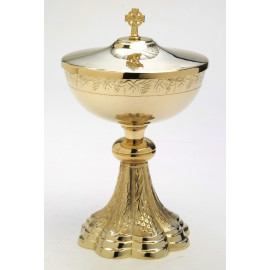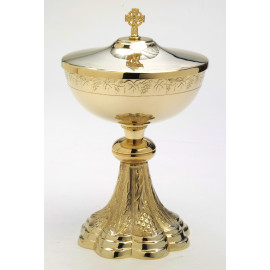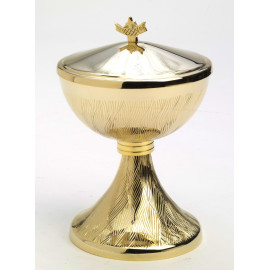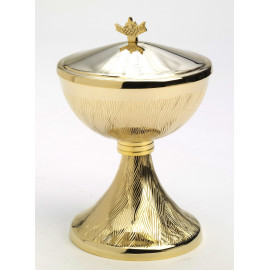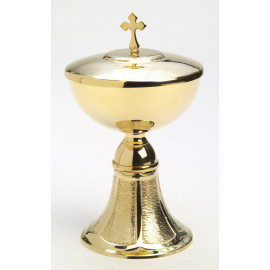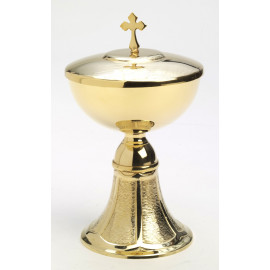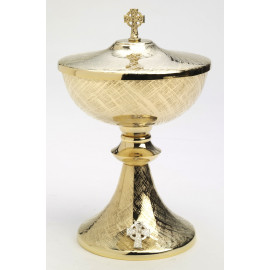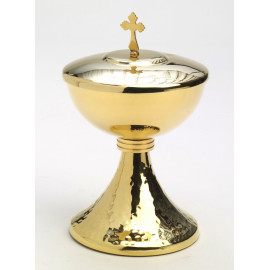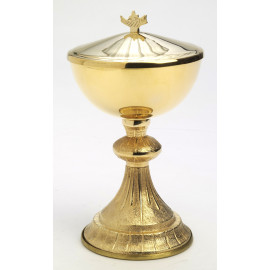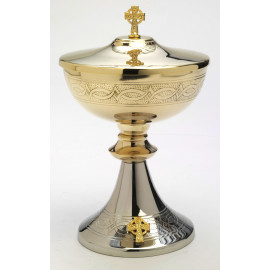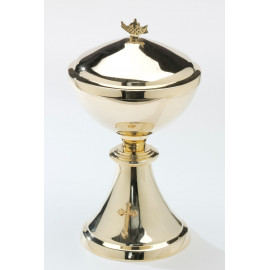No products
Product successfully added to your shopping cart
There are 0 items in your cart. There is 1 item in your cart.
Ciborium
- Altar Bell and Gong
- Candle Snuffer
- Candlestick
- Catholic Pyx
- Chalices
- Church wall lamps
- Ciborium
- Crosses and Crucifix
- Cruets & Trays
- Holy Water Font
- Holy Water Pot
- Missal Stand
- Monstrance Tabor
- Monstrances
- Offering Baskets
- Oil Stock
- Patens
- Reliquaries
- Sanctuary Bells
- Sanctuary Lamp
- Sprinkler
- Thurible, Boat, & Spoon
- Travel Liturgy & Mass Kit
A ciborium is a vessel, usually made of metal, that is used to hold the consecrated bread or sacred wafers for the Eucharist in Roman Catholic, Anglican, Lutheran, and related churches. The word "ciborium" comes from the ancient Greek word "kibōrion," which referred to a cup-shaped seed vessel of the Egyptian water-lily nelumbium speciosum and later came to describe a drinking cup made from that seed casing or in a similar shape. In medieval Latin and in English, "ciborium" more commonly refers to a covered container used to store the consecrated hosts of the sacrament of Holy Communion. The ciborium is usually shaped like a rounded goblet, or chalice, having a dome-shaped cover. Its form originally developed from that of the pyx, the vessel containing the consecrated bread used in the service of the Holy Communion. The ciborium is not a consecrated vessel and needs only a blessing before it is first used. The vessel can be made of either silver or gold, but the interior of the cup must be lined with gold.
A ciborium is a vessel, usually made of metal, that is used to hold the consecrated bread or sacred wafers for the Eucharist in Roman Catholic, Anglican, Lutheran, and related churches. The word "ciborium" comes from the ancient Greek word "kibōrion," which referred to a cup-shaped seed vessel of the Egyptian water-lily nelumbium speciosum and later came to describe a drinking cup made from that seed casing or in a similar shape. In medieval Latin and in English, "ciborium" more commonly refers to a covered container used to store the consecrated hosts of the sacrament of Holy Communion. The ciborium is usually shaped like a rounded goblet, or chalice, having a dome-shaped cover. Its form originally developed from that of the pyx, the vessel containing the consecrated bread used in the service of the Holy Communion. The ciborium is not a consecrated vessel and needs only a blessing before it is first used. The vessel can be made of either silver or gold, but the interior of the cup must be lined with gold.
Ciborium There are 29 products.
Understanding the Liturgical Ciborium
The liturgical ciborium is a vessel steeped in history and symbolism within the Christian tradition. It is a container, often made of precious metals, used to hold the consecrated hosts—bread that has been blessed and is believed to become the Body of Christ during the Eucharist. The ciborium's role in liturgical ceremonies is both practical and deeply spiritual, serving as a safeguard for the hosts and a symbol of reverence for the Holy Eucharist.
The Historical Significance of the Ciborium
Tracing its roots back to ancient times, the ciborium has evolved in both form and function. The term itself has a somewhat uncertain etymology, with some attributing it to the Latin word "cibus," meaning food, and others to the Greek "kiborion," a type of cup. Initially, the ciborium was not only a vessel but also referred to the architectural canopy over altars in early Christian churches, signifying the sacredness of the space below.
The Ciborium in Liturgical Practice
In modern liturgical use, the ciborium is primarily a vessel for holding the Eucharistic bread. It is typically crafted from gold or silver, with the interior always lined with gold to honor the sanctity of its contents. The ciborium is not consecrated but is blessed before use, and when containing the Sacred Species, it is covered with a white veil, symbolizing purity and respect for the presence of Christ.
Architectural Ciboria and Their Symbolism
While the ciborium as a vessel is common in liturgical practice, the architectural ciborium, or canopy, has a rich history of its own. These structures, supported by columns and often adorned with curtains, were used to cover altars and emphasize their importance within the church setting. The architectural ciborium represents the place of Christ's crucifixion and resurrection, drawing a parallel to the Holy of Holies in the Jewish Temple.
The Ciborium's Role in Church Architecture
The use of ciboria in church architecture has seen a decline over the centuries, with the introduction of screens and altarpieces that obscured the view of the altar. However, there has been a revival in their use, particularly in churches that aim to highlight the altar's significance in line with the liturgical reforms of the Second Vatican Council.
FAQs About the Liturgical Ciborium
What is a liturgical ciborium?
A liturgical ciborium is a covered container, often made of precious metals, used to hold the consecrated hosts during the celebration of the Eucharist in Christian liturgical practices.
How is the ciborium used in a church service?
During Mass, the ciborium is used to distribute Holy Communion to the faithful. It is also used to reserve the consecrated hosts in the tabernacle for later distribution, especially to the sick or those unable to attend Mass.
What does the ciborium symbolize?
The ciborium symbolizes reverence and protection for the Body of Christ. It also represents the tomb of Christ when used in its architectural form, signifying the death and resurrection of Jesus.
How is the ciborium treated differently from other liturgical vessels?
While the ciborium is not consecrated, it is blessed before use. When it contains the consecrated hosts, it is covered with a white veil and handled with great reverence, reflecting the belief in the real presence of Christ in the Eucharist.
Can anyone touch the ciborium?
When the ciborium contains the consecrated hosts, only ordained ministers are permitted to handle it. When empty and purified, it may be touched by clerics, and laypersons may do so if specially authorized.
In conclusion, the liturgical ciborium is a vessel of honor and a testament to the enduring tradition of the Christian faith. Its presence in liturgical ceremonies serves as a tangible connection to the sacred mysteries of the Eucharist, embodying both the historical richness and the spiritual depth of Christian worship.

